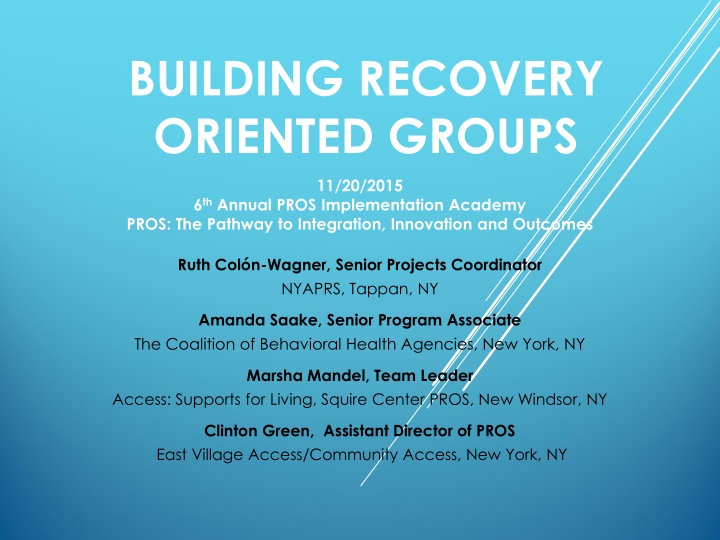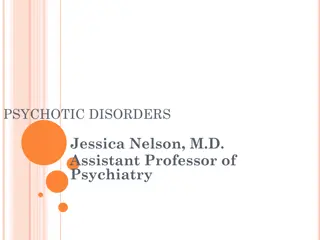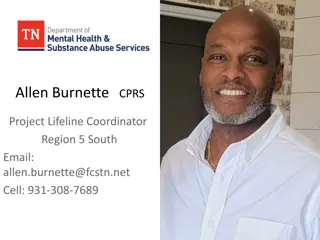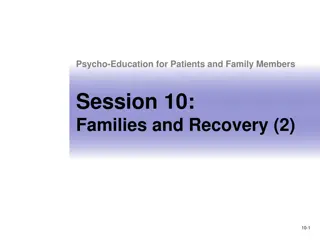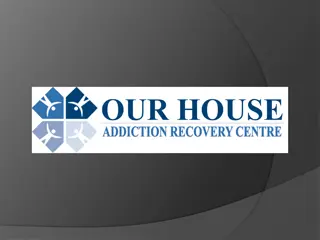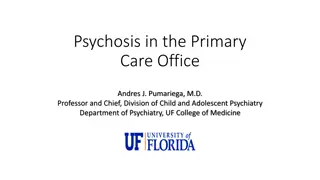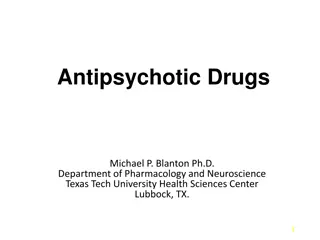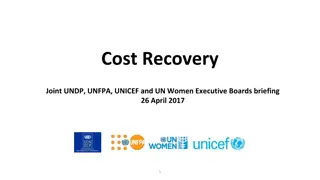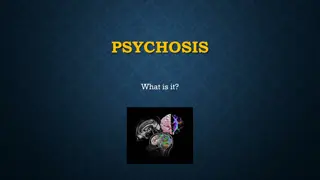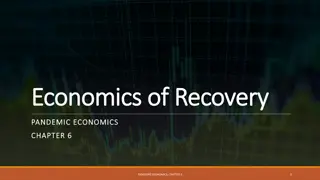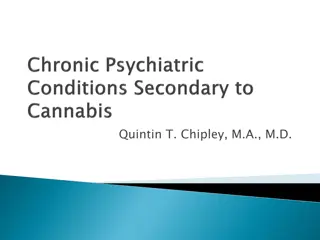Building Recovery-Oriented Groups: Enhancing Support for Individuals with Psychotic Symptoms
This presentation highlights the importance of specialized clinical groups for individuals with hallucinations and delusions in a PROS setting. It addresses the unique needs of this severely afflicted sub-population, emphasizing the value of a safe and supportive environment for exploring, understanding, and coping with symptoms. The discussion focuses on overcoming stigma, isolation, and the isolating nature of symptoms in order to promote healing and recovery.
Download Presentation

Please find below an Image/Link to download the presentation.
The content on the website is provided AS IS for your information and personal use only. It may not be sold, licensed, or shared on other websites without obtaining consent from the author.If you encounter any issues during the download, it is possible that the publisher has removed the file from their server.
You are allowed to download the files provided on this website for personal or commercial use, subject to the condition that they are used lawfully. All files are the property of their respective owners.
The content on the website is provided AS IS for your information and personal use only. It may not be sold, licensed, or shared on other websites without obtaining consent from the author.
E N D
Presentation Transcript
BUILDING RECOVERY ORIENTED GROUPS 11/20/2015 6th Annual PROS Implementation Academy PROS: The Pathway to Integration, Innovation and Outcomes Ruth Col n-Wagner, Senior Projects Coordinator NYAPRS, Tappan, NY Amanda Saake, Senior Program Associate The Coalition of Behavioral Health Agencies, New York, NY Marsha Mandel, Team Leader Access: Supports for Living, Squire Center PROS, New Windsor, NY Clinton Green, Assistant Director of PROS East Village Access/Community Access, New York, NY
LEARNING TO TRUST MYSELF AND OTHERS Clinical group specifically and only for individuals who have hallucinations and delusions. Marsha Mandel, Team Leader Access: Supports for Living, Squire Center PROS, New Windsor, NY
WHY THIS GROUP IS NEEDED IN PROS Severely Afflicted Sub-Population in PROS Many groups address depression, anxiety, stress, life role changes, addiction, grief, distorted thinking and other more common issues. Many groups help to develop mindfulness, acceptance, rational thinking skills, emotion regulation, assertiveness, basic living skills, self-compassion broadly applicable skills. All of these may be helpful for individuals with psychotic symptoms, but they do not provide the opportunities to safely explore, understand and develop specific skills for coping with them, nor the opportunity to utilize group support and dynamics to do so.
WHY THIS GROUP IS NEEDED IN PROS Isolating Nature of Symptoms Paranoia inhibits sharing in heterogeneous MH groups. Past sharing of hallucinatory experiences has led to conditioned withdrawal and guardedness. A dedicated, homogeneous group provides: - A safe place with others to mutually share focus, exploration, understanding and support alleviating isolation. Clients say, I thought I was the only one.
WHY THIS GROUP IS NEEDED IN PROS Stigma within PROS leads to shame, embarrassment, isolation Inadvertently, comments are made by peers who are not in this subset: At least I don t hear voices. I m not thatcrazy. In a homogeneous group, individuals experiences are recognized in their similarity, with respect for differences, providing normalization of the experiences, safety to explore, and engaged interactions. Your voices are quiet sometimes? Mine never shut up! I like to believe it s my mother communicating with me. How do youhandle when they keep telling you what to do?
WHY THIS GROUP IS NEEDED IN PROS Stigma at home perpetuates shame and embarrassment. You are NOThearing voices! I don t want to hear it! Just stop listening! Talking to yourself again? Stop acting crazy! She s just being stupid. Negative, fear-driven responses to disclosure lead to fear of disclosure even to clinicians. A dedicated group offers proof that voice hearers, shadow seers, and those who are convinced that others are filled with harsh criticisms and plotting against them are not alone.
MEMBERS SAY: I can t talk about this stuff in other groups. This is the only place I talk about the voices.
THIS GROUP OFFERS SUPPORT WITH: Considering the roots of the experience Irrational negative assumptions and beliefs about the root of the experience result from isolation and internalized stigma. Irrational beliefs that one is cursed, voices have authority, are correct, have control, or are external entities, serve to amplify distress. Discussing with others reveals new possibilities. No one has the right to tell another what his or her experience is rooted in; each individual has the right to choose, and there is a choice. I used to think he was a demon, but now I believe it is a symptom. I d like to think the shadow is my brother keeping an eye on me.
Considering the roots of the experience Support this by: UtilizingMI reflective listening techniques to validate and offer alternatives. - Offering information which others have found helpful and may be helpful to them as well, and by not imposing your view. - Providing psychoeducation regarding possible causes of the experiences such as neurochemical imbalance, structural abnormalities, genetic predisposition, stressors triggering the onset. - Asking questions to promote new perspectives such as, Which of these interpretations make sense to you? , Which belief would you feel more comfortable believing? and If you could choosea cause of your experience, which would you choose? -
THIS GROUP OFFERS SUPPORT WITH: Normalization, Decreased Shame & Isolation Members are no longer alone. It is safe to share because there is: true empathy familiarity no outcast genuine support sincere understanding meaningful connection Members become comfortable and empowered, facilitating sharing and exploration, which decreases shame & isolation.
For many, this is the first time they have ever felt safe enough to disclose. My voices come from inside. They argue with each other and make comments about me and other people. Sometimes they tell me what to do. Sometimes I hear and see someone talking, and I can t tell if it s real. They are just so loud sometimes I just need to take a nap. There s a party going on up there. I don t know whether to laugh or cry. I see shadows too. They used to bother me but I don t pay attention. They try to get me to pick up a beer. I always feel like everyone is judging me.
Normalization, Decreased Shame & Isolation Support this by: - Informing them that millions of people experience hallucinations and delusions. - Encouraging interaction: Who else has experienced something like this? , How do others in the group cope with this experience? - Directly addressing the stigma by acknowledging it exists and discussing and sharing what forms it takes for members. Provide support and validation. - Bringing in materials from people who have shared publicly such as Patricia Deegan, Bill McPhee, David Crepaz-Keay and Eleanor Longden.
THIS GROUP OFFERS SUPPORT WITH: Developing Healthier Responses to the Experiences False perceptions often result in well-practiced patterns of thoughts, emotions and behaviors that reinforce negativity and distress. Schemas lose their grip with peer and professional support, allowing new interpretations of experiences and healthier patterns of response. I used to believe them, but now I realize they are not reliable and I can disagree. I don t need to cut. The voices are influential but they don t control me, and I know I want to stay out of the hospital.
Developing Healthier Responses to the Experiences Support this by: - UtilizingCBT to support seeking evidence of rational, healthy interpretations, and seeking evidence to refute distortions. Ask questions. Be non-confrontational and validating. - Facilitating group exploration, support and engagement in the CBT process. Most members have only done this in individual sessions. - Directly addressing symptom stress. These experiences may be tolerated, just as distressing realities may be tolerated.
THIS GROUP OFFERS SUPPORT WITH: Helping Members Learn to Challenge Perceptions People who live with experiences that are not shared by others typically, without support, accept their experiences as reality. Reality Testing is a powerful skill to develop in this group, for members to learn and utilize independently. I was watching an old Friends episode and heard them talking about me. I decided to rewind it and found that they were talking about something else. I saw people around the room but didn t understand why they were there. I called my sister in and she said there was no one there.
Helping Members Learn to Challenge Perceptions Support this by: Encourage reality testing every time you notice an opportunity! When a participant with paranoia says she has the feeling everyone doesn t like her and is talking about her, bring up the skill to the group: Let s do some reality testing. Make it a regular feature of the group. Tell her it is up to her to consider her peers and the facilitator are being genuine, and ask each person, Have you had a bad thought about Sue? Directly share that you have not had a bad thought either. Remind her it is up to her to consider the possibility that people are being sincere. Directly offering this choice elicits cognitive flexibility through alignment and helps to loosena rigid paranoid lens.
Helping Members Learn to Challenge Perceptions Support this by utilizing skills such as mindfulness to: - note thoughts as they occur - tune in to an increase in paranoia - take a helicopter view - encourage having the thoughts as opposed to being submerged in them. Peer understanding and support make all the difference in a group setting vs an individual session. Individuals sharing their experiences with paranoia in mutual support of each other provides a deeper, more profound level of empathy and understanding. Reality testing becomes more meaningful when the possession of paranoid lenses has been shared.
Helping Members Learn to Challenge Perceptions Support this by: - Looking for more opportunities for group reality testing to promote the skill, bonding and sometimes, humor. When a member leaves the room, ask, How many people here think he left because of you? If there is laughter in the hallway, ask, How many people here thought that was about you? Watch every hand go up, mutual surprise and understanding, deep connections and laughter. People with paranoia will not share this unless directly asked. This offers the opportunity for proof that there is deep personal understanding of paranoia. This offers the opportunity to mutually share the experience, be amazed and even laugh together.
NOTES ON GROUP STRUCTURE - Each group starts with a statement of the special nature of the group. - To directly set the tone of and for this special group. - That it is the place to talk about experiences that are not shared by others. - That it is a safe place to talk about experiences of hearing, feeling, seeing or believing things, that others do not share. - That these concerns that are difficult to talk about elsewhere, are shared and supported here. - That all members beliefs and interpretations are respected.
LOGISTICS - This is not an auditable group. When a community member wants to audit, kindly let them know that it is not auditable, may not be appropriate for them, and that they can speak with their clinician to learn more. Let them know they are certainly welcome to enroll if it is appropriate for them. - The facilitator of this group informs other staff about the nature of the group to avoid errors in enrollment. - The facilitator is continually observant, noting any signs of false perceptions that may be explored and processed during the group, in the here and now.
LOGISTICS - This group stays on topic. Members look forward to and savor this group. - Check in with each member in each session. The profiles of group members tends towards inhibition. Members know this is a safe place, there is no pressure and there will be a gentle check in. - Rogerian person-centered core conditions of: - Unconditional Positive Regard - Accurate Empathy - Counselor Congruence are essential for this group
